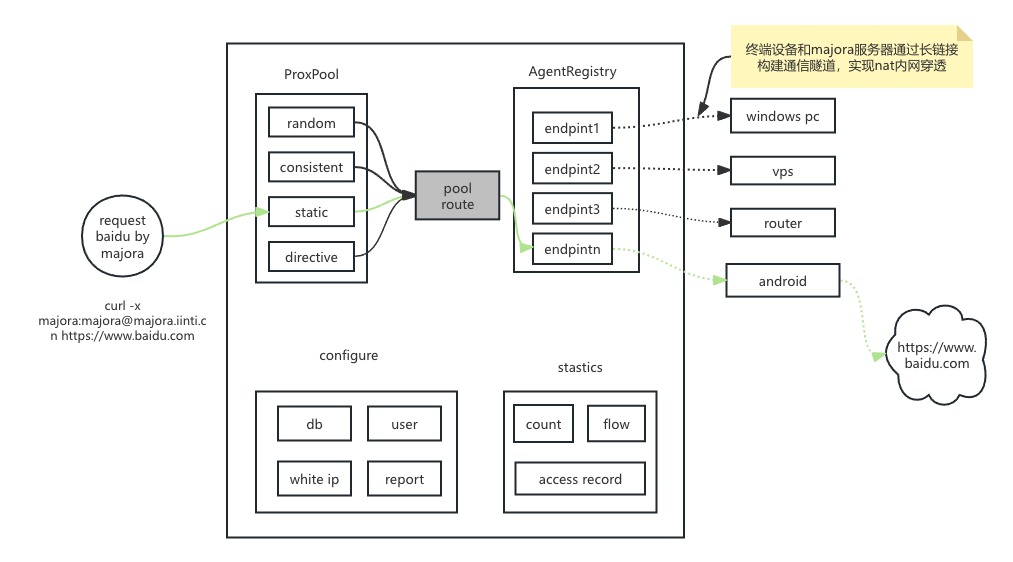Introduction
Introduction
Majora is a centralized platform for building a proxy IP pool cluster. As illustrated below, you only need to deploy a single server and install the endpoint agent on the devices that will contribute traffic. Majora will orchestrate the devices into a unified proxy resource pool.
- For IP proxy providers: Rapidly assemble your VPS nodes, dial-up resources, and DSL exits into one managed proxy pool that can be sold to customers.
- For in-house crawling teams: Run a dedicated, fully controlled proxy pool—especially important for transactional scenarios where a session must keep the same IP.
- For mobile 4G pools: Our stable Android client lets you run the agent on phones or Android dev boards and offer unique 4G mobile traffic.
- For proxy re-export scenarios: If you already have a proxy pool, Majora's exporter module can wrap it as a new pool—even when the original pool lives behind NAT.
- For residential/home pools: Easily connect routers and consumer devices in overseas locations to provide home IP resources.
Core Concepts
The following diagram highlights the high-level architecture so you can understand how Majora works and get the most out of it.

IP Pools
Majora ships with five built-in pool models. Each pool exposes multiple ports, and every port acts as a proxy endpoint.
- Random: Each request is routed to a random healthy node. There is no binding between traffic and supplier, which is ideal for stateless crawling workloads.
- Static: Every port is permanently bound to a node. The exit IP never changes, making it perfect for long‑running cross-border e-commerce sessions that must keep a stable IP.
- Consistent: Ports and nodes are mapped with consistent hashing. When a node goes offline, traffic is temporarily reassigned and then automatically switched back once the node returns. This model balances stability and capacity and is the recommended default for large crawler pools.
- City: Ports are bound to cities so that:
- Multiple ports are exposed, each mapped to a dedicated city.
- A given user accessing the same port will keep the same city and the same serving node, ensuring IP stability even if the city has many exits.
- Different users hitting the same port are mapped to different nodes, achieving load balancing inside the city pool.
If you need to expose the port-city mapping to customers, fetch it via the HTTP API and distribute the latest mapping. The system keeps a 15-minute affinity window so ongoing sessions are not affected by topology changes.
- Directive: The username can carry dynamic parameters so that each request can control routing decisions. This enables advanced strategies such as country/city allocation or latitude/longitude-aware routing. More directive variants will be added over time.
Endpoints
Endpoints are the devices that deliver the actual proxy traffic. The more endpoints you have, the larger your resource pool. Because the server acts as a central controller, endpoints only need to connect to it—no complex on-site setup is required:
- A single config parameter (the Majora server address) is enough to onboard an endpoint.
- Devices can live in any network environment without special provisioning.
- Built-in NAT traversal makes it easy to support phones, desktop apps, or routers with no public IP.
We provide agents for a wide range of scenarios so you can mix and match different device types in one pool.
